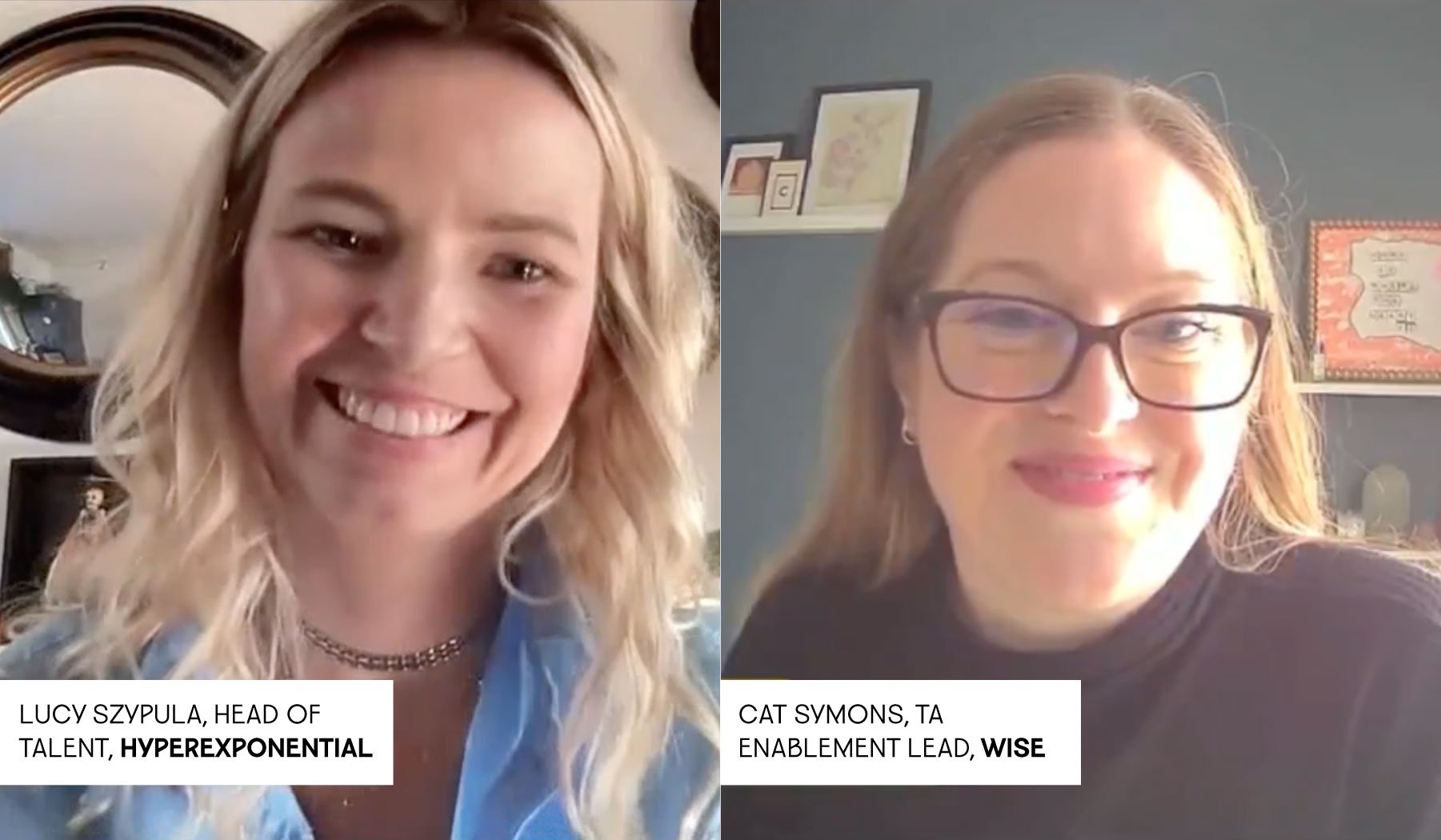Signal vs. Noise: Thoughts on Hiring From Wise & Hyperexponential
-

Alysia Wanczyk
Read more posts by this author.

Alysia Wanczyk

In today's rapidly changing job market, recruitment processes are undergoing significant transformations. As companies strive to attract and retain the right talent, understanding the dynamics of the current hiring landscape has never been more important.
We recently sat down with Cat Symons, Global Talent Acquisition Enablement Lead at Wise, and Lucy Szypula, Head of Talent at Hyperexponential, to hear how they’re tackling these challenges; and get their take on the practical steps talent leaders can take to find their people.
Optimise for signal, not volume
With unemployment on the rise and job vacancies declining, application numbers are swelling. But more isn’t always better: both Cat and Lucy warned that focusing on application volume can actually make it harder to spot great talent. The real challenge? Cutting through the noise to find genuine signals.
Lucy explains, “Noise can come from outside. But you can also create a lot of noise internally if you’re not really keeping your hiring teams accountable ensuring they have everything they need to confidently make those decisions, and look for the things you care about in candidates.”
”For us, it’s always optimising for signal. And that also means that we invest a lot of time in ensuring alignment because there is no worse thing than having thousands of applications, but on top of that, you don't have a completed intake meeting or your hiring team isn't aligned on what they're actually looking for.”
Our takeaway: quality hiring decisions start with alignment, not volume. It’s worth investing time in rigorous intake meetings with your hiring stakeholders. Make sure everyone involved in hiring is clear on what’s essential, what’s negotiable, and what a great candidate truly looks like. And then, make sure that this clarity of expectation comes through in your job posts.
Use strategic friction as a filter
It’s tempting to make the application process as easy as possible, but sometimes a little “friction” can be a powerful filter. At Hyperexponential, the team adds carefully chosen application questions to help candidates self-select in and out of applying. Job descriptions include sections like “You’re unlikely to thrive here if…”, designed to be bold and upfront about culture and expectations.
Lucy’s advice: “We believe it’s our job to equip everyone to make their decision. If candidates are finding this off-putting, they are unlikely to thrive here anyway. So we’re seeing it as a win-win situation for sure [being clear and up-front in their job descriptions].”
Don’t be afraid to be honest about what your company is (and isn’t), and what you’d expect from someone who will thrive in your environment. The right candidates will lean in and be excited about the opportunity and company if you’re transparent. The wrong ones will likely opt out if your ways of working or values aren’t a good fit with what they’re looking for, so lay it all out so as to not waste their, or your team’s, time.
Implement inline assessments at the top of the funnel
Instead of carefully evaluating whether they're a good fit before even applying to a role, candidates are increasingly applying broadly and letting TAs do the filtering. They've shifted the burden of qualification, skills, and experience assessment from themselves to already stretched talent teams.
At Wise, the team puts technical tests and skills assessments at the very start of the process - not after initial CV screens. This creates what Cat calls “good friction.” Candidates who are motivated and genuinely interested will complete the assessment; those who aren’t will move on.
“We see it [technical tests] as good friction. If somebody wants to work for Wise and this is part of their application, we would assume that they would complete the test to do it,” she says.
The impact? Higher conversion rates from application to first interview, and a much clearer sense of who’s really invested in the opportunity.
Be ruthless with data-driven channel management
Not all hiring channels are created equal. Both Wise and Hyperexponential regularly analyse not just application volume, but conversion rates and quality of hire by source. If a channel consistently brings in low-quality candidates, it gets cut - regardless of volume.
Lucy points out, “What we see when we screen candidates through Welcome to the Jungle is that they come to all of the screenings and all of even the initial interactions much, much warmer and with a better understanding of what Hyperexponential does and what our mission is. That already is a massive time saver for us because we can then dive deeper into what we actually need to test for and look for that signal rather than just spend our time selling.”
Cat adds, “We continue to make sure that our adverts are attracting diverse candidates and this is where I personally find Welcome to the Jungle really adds value to our hiring because of the data we can also pull from the platform and working with our customer success manager there.”
The bottom line: Track your sourcing data ruthlessly. Be aware of your success metrics at the top of your funnel to understand what’s worth investing in to engage candidates at the right level and with the right experience. On Welcome to the Jungle, talent teams can see the performance of sourcing and applications separately, and can get a sense of who is coming in and falling out of the funnel by gender, ethnicity, experience level and more - all from a clear analytics dashboard, without guessing or complicated reports.
Leverage AI for process optimisation (keep humans in decision-making)
Both Wise and Hyperexponential are harnessing AI to handle admin tasks. Cat says, "We use AI note takers in all of our screening calls, kickoff meetings, and debrief meetings of hiring teams." This frees up recruiters to do what they do best: connect, assess, and create a thoughtful candidate experience.
And Lucy admits, "We are 100% maximalist when it comes to process optimisation and looking for ways in which AI can help us do even more of what we actually love." AI is still seen as a tool to remove admin burden and streamline candidate experience, not to replace judgment or empathy. Both organisations believe it’s important to keep humans in charge of hiring decisions.
Embrace transparency in employer branding
Candidates are more discerning than ever, and glossy employer brand content alone won’t cut it. Both Cat and Lucy emphasised the value of being upfront about both the positives and the challenges of working at their organisations.
Research-based EVP (employee value proposition) development - using employee interviews and workshops - creates authentic, credible messaging. Being honest about your culture, pace of change, and expectations helps attract people who will truly thrive. For you to find your people. A great way to do this is with videos that help showcase what your people are like (in their own words), what the office environment is like, and bring to life what words, alone, can’t.
Cutting through application noise isn't about working harder
It's about being authentic, transparent, and clear about who you are as a business, like Wise and Hyperexponential. You can watch our conversation on demand here.
By leveraging technology, enhancing candidate experiences, and focusing on authentic employer branding, you can better navigate modern recruitment challenges and connect with more of the right people. For more insights on how employer branding cuts through the noise, explore our employer branding solutions.

For queries and support, email companies@welcometothejungle.com.
For press enquiries, email press.uk@welcometothejungle.com.
Welcome to the Jungle is a trading name of Otta Technology Ltd. Company number: 11794989.
First Floor, Mindspace, 142-146 Old St, London EC1V 9BW